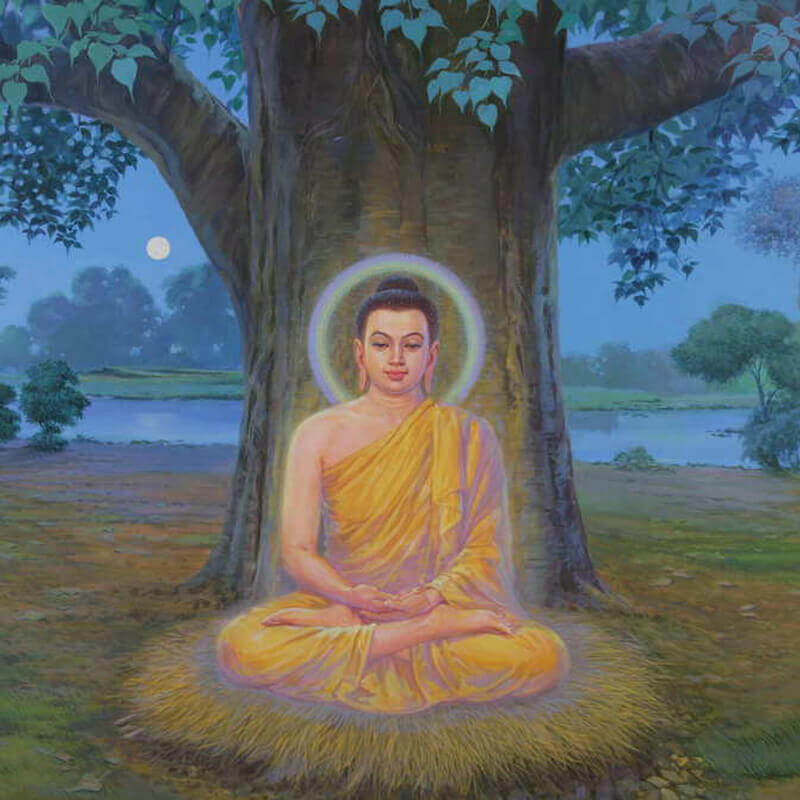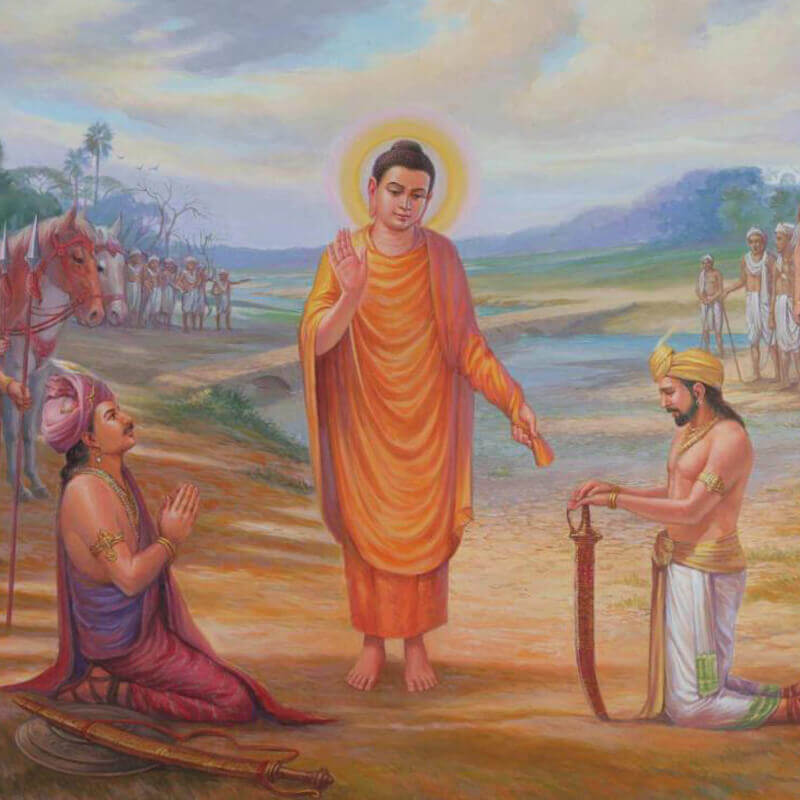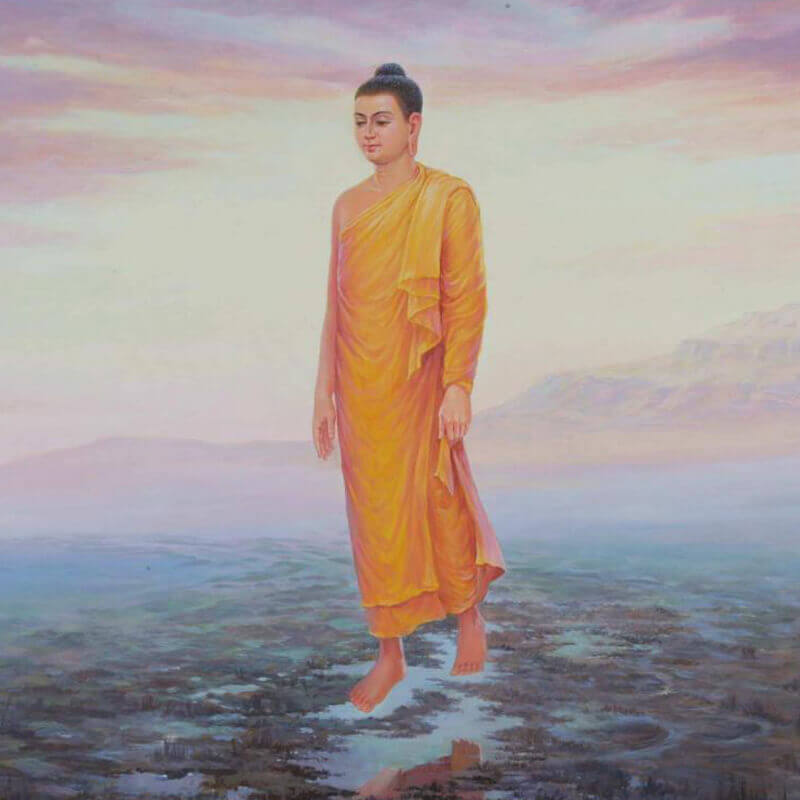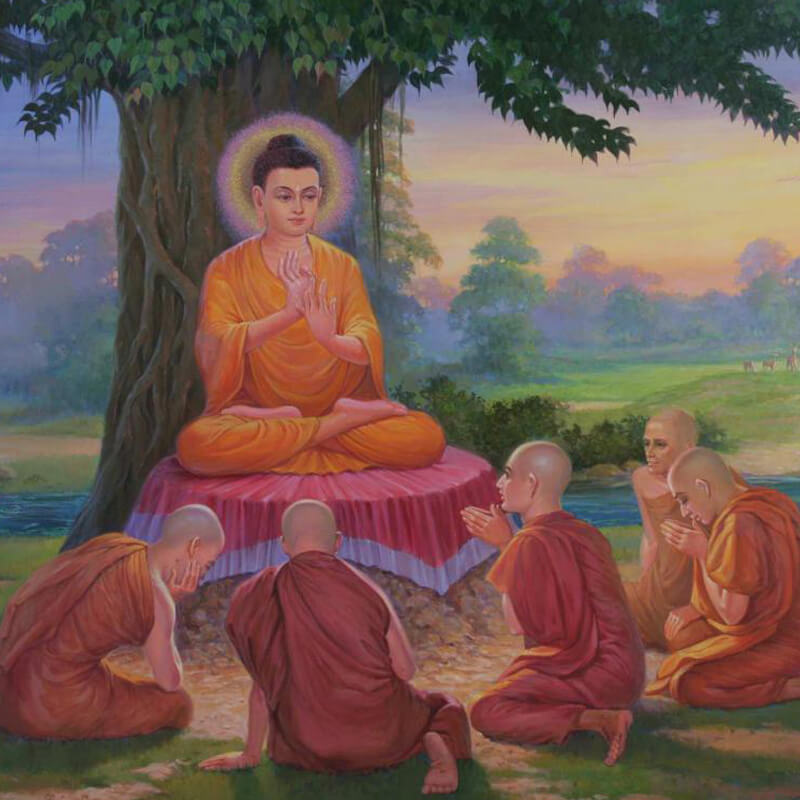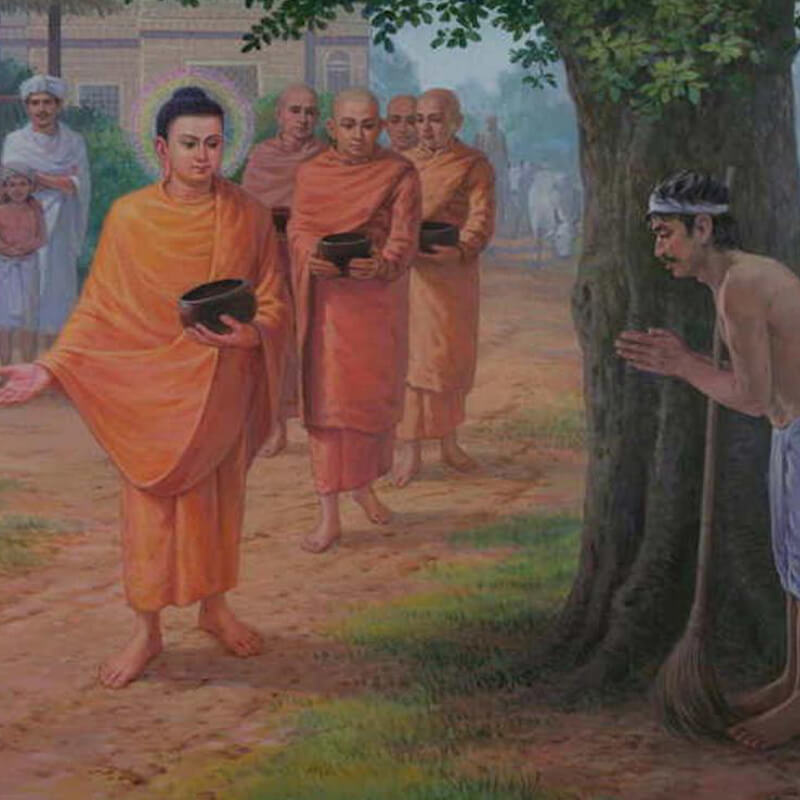The Preparation to Become a Buddha
Gotama Buddha is the fourth of the five Buddhas to arise in the world-cycle which is known as a Bhadda-kappa (an auspicious world-cycle). His predecessors were the Buddhas Kakusanda, Konagamana, and Kassapa. There were also innumerable Buddhas who arose in earlier world-cycles and who preached the very same Dhamma that gives deliverance from suffering and death to all matured beings. Buddhas are all compassionate, glorious, and enlightened.
A hermit by the name of Sumedha was inspired by Buddha Dipankara—so much so, that he took the vow to make all the necessary preparations to become a Buddha in the course of time. Buddha Dipankara gave him his blessings and prophesied that he would become a Buddha by the name of Gotama after a lapse of four incalculable periods of world cycles plus one hundred thousand world-cycles (kappas). From then onwards, existence after existence, the Bodhisatta (future Buddha) conserved mental energies of the highest order through the practice of the ten paramitas (or paramis, virtues leading toward perfection):
- Dana-parami: Virtue in alms-giving (or generosity)
- Sila-parami: Morality
- Nekkhamma-parami: Renunciation
- Panna-parami: Wisdom
- Viriya-parami: Great effort (or perseverance)
- Khanti-parami: Forbearance (or patience)
- Sacca-parami: Truthfulness
- Aditthana-parami: Determination
- Metta-parami: All-embracing love
- Upekkha-parami: Equanimity
It is, therefore, a most arduous task to become a Buddha. Utmost strength of will-power is necessary even to think of it. The Bodhisatta’s preparatory period came to an end with the life of King Vessantara[1] who excelled any living being in alms-giving. He gave away his kingdom, his wife and children, and all his worldly possessions, for the consummation of his solemn vow taken before the Buddha Dipankara. The next existence was in the Tusita (celestial plane) as the glorious deva Setaketu, until he got his release from that plane of existence and took conception in the womb of Maya-Devi, the queen of King Suddhodana of Kapilavatthu, a place near modern Nepal.
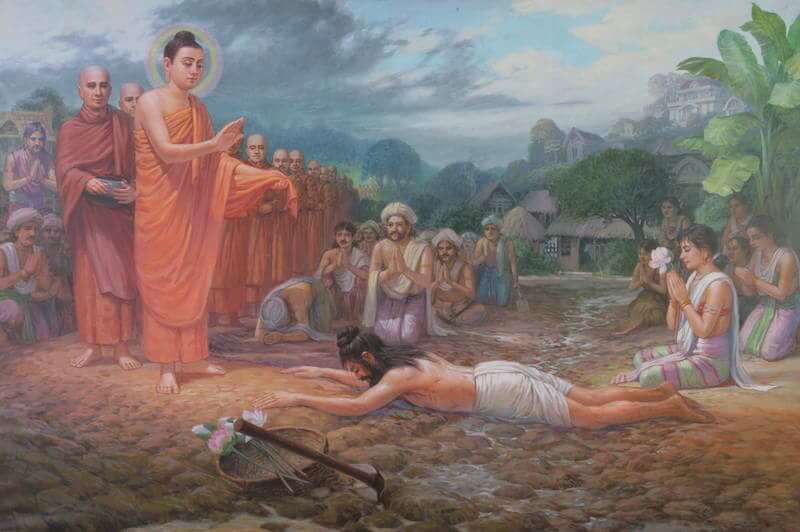
Early Years
History tells us that in 624 B.C. King Suddhodana ruled the kingdom of Sakya. He had two queens: the chief queen was Mahamaya and the younger queen was Mahapajapata Gotami, the sister of Mahamaya.
When time was drawing near for her confinement, the queen expressed her desire to go to the place of her own parents for the event. King Suddhodana accordingly sent her there with a befitting retinue and guards. On the way, a halt was made at the Lumbini Grove. She descended from her palanquin and enjoyed the cool breeze and fragrance of sal flowers. While holding out her right hand to a branch of a nearby sal tree for a flower, all of a sudden and unexpectedly, she gave birth to a son who was to become the All-Enlightened Buddha. Simultaneously, the natural order of things in the cosmos was revolutionized in many respects and thirty-two wonderful phenomena were vivified. All material worlds were shaken from their foundations up. There were unusual illuminations in the solar system. All the beings of the material planes could see each other. The deaf and dumb were cured. Celestial music was heard everywhere, and so on.
At that moment, Kaladevala, the hermit teacher of King Suddhodana, was discoursing with the celestial beings of the Tavatimsa deva world. He was a hermit of fame who had mastered the eight attainments (samapattis) which gave him super-normal powers. Learning of the birth of a son to the king in the midst of the rejoicing in all the rupa and kama worlds, he hurried back to the palace and desired the baby to be brought before him for his blessings. As the king was about to place the baby before his teacher for the occasion, a marvel took place. The baby rose into the air and rested his tiny feet on the head of Kaladevala who at once understood that the baby was no other than the Embryo Buddha. He smiled at this knowledge, but cried almost immediately thereafter, because he foresaw that he would not live to hear his teachings, and that after his death, he would be in the arupabrahma-loka (the immaterial planes of the brahmas) whence he would have no relationship with any of the material planes. He regretted bitterly that he would miss the Buddha and his teachings.
Birth of Gotama
On the fifth day, the child was named Siddhattha in the presence of renowned astrologers who agreed that the child had all the characteristics of a Buddha-to-be. His mother, the queen, however, died a week after her confinement, and the child was taken care of by his maternal aunt, Pajapati-Gotami.
At the young age of sixteen, Siddhattha was married to Yasodhara, a beautiful princess. It was his father’s hope that she would bind him to the family life. Until the age of twenty-nine he lived the life of a householder amidst great luxury and ease and culture. He was acclaimed to be a prodigy in both intellect and strength. The king spared no pains to make the course of his life smooth. Three separate palaces were built to suit the three seasons (hot, cold, and rainy) with all the necessities that would make the prince sink in sensuality. That was because the king, out of paternal affection, desired his son to remain in worldly life as a king rather than become an Enlightened Buddha. King Suddhodana was ever watchful that his son should be in an environment that would give him no chance for higher philosophical ideas. In order to make sure that the thoughts of the prince would never turn in this direction, he ordered that nobody serving him or in his association was ever to speak a single word about such things as old age, sickness, or death. They were to act as if there were no unpleasant things in this world. Servants and attendants who showed the least sign of growing old, weak, or sickly were replaced. On the other hand, there was dancing, music, and enjoyable parties right through, to keep him under a complete shade of sensuality.
The Great Renunciation
As days, months, and years passed, however, the monotony of the sensual surroundings gradually lost their hold over the mind of Prince Siddhatta. The mental energies of virtue conserved in all his earlier innumerable lives for the great goal of Buddhahood were automatically aroused. At times, when the world of sensuality lost control over his mind, his inner self worked its way up and raised his mind to a state of purity and tranquility with the strength of samadhi (concentration) such as had raised his baby form into space and onto the head of Kaladevala. The war of nerves began. An escape from sensuality and passion was his first consideration. He wanted to know what existed outside the walls of the palace, for he had not gone out even once. He wished to see Nature as it is and not as man has made it. Accordingly, he decided to see the royal park, outside the palace walls. On the way to the park, in spite of the precautions taken by the king to get the roads clear of unpleasant sights, he saw an old man bent with age on the very first visit. Next he saw a sick person in the agony of a fatal malady. Thereafter he met with a human corpse. On the last trip he came across a monk. All these predisposed his mind to serious thinking. His mental attitude was changed. His mind became clear of impurities and tuned up with the forces of his own virtues conserved in the sankhara-loka (the plane of mental forces). By then, his mind had become freed from hindrances, was tranquil, pure, and strong. It all happened on the night when a son was born to his wife, a new fetter to bind him down. He was, however, immune to anything which would tend to upset the equilibrium of his mind. The virtues of determination worked their way for a strong resolve, and he made up his mind to seek the way of escape from birth, old age, suffering, and death. It was midnight when the solemn determination was made. He asked his attendant Channa to keep his stallion Khanthaka ready. After a parting look at his wife and the newly born babe, Prince Siddhattha broke away from all the ties of family and of the world and made the Great Renunciation. He rode across the town to the river Anoma, which he crossed, never to return until his mission had been achieved.
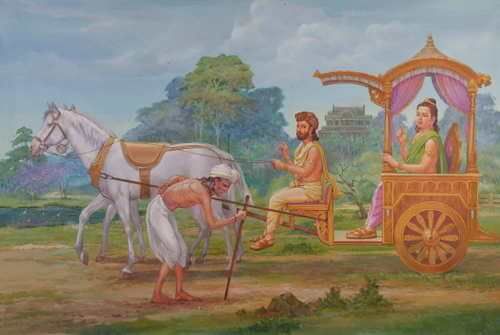
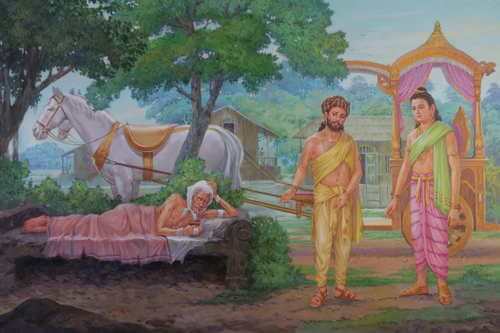
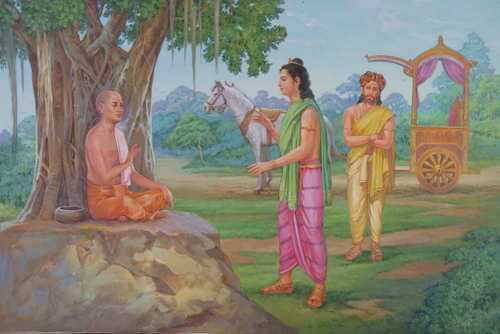
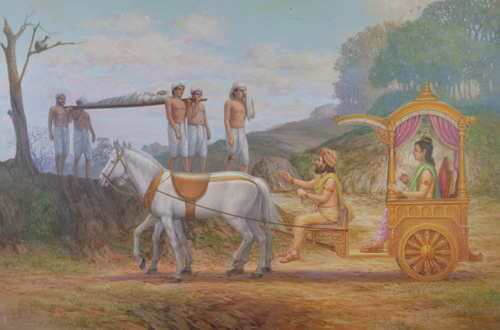
In search of truth
The Journey to Magadha

Prince Siddhattha crossed the river Anoma, took the robes of a recluse and proceeded towards Magadha. He was new to the life of a monk. Close to Anupriyā village, there was a mango orchard. Staying there for a week, he experienced for the first time the happiness of monk-hood. To learn meditation, he decided to go to the teacher named Alara Kalama (Ālāra Kālāma).
From Anupriyā village, he went straight to Rajgir (Rajagaha, the capital of Magadha kingdom). On the main street of the city, he started walking from house to house for alms. The people were impressed by his radiant face and long-limbed (ājānubāhu) body. They had never seen such an attractive monk. Whoever saw him kept gazing at him.
The king of Magadha also couldn’t contain himself when he saw the monk on his alms round from his balcony. He felt that this monk was not an ordinary person. So he asked his men to follow the monk. They saw that as soon as the monk received enough alms-food, he went to the Pandu cave on the outskirts of the city, sat on a stone and started eating.
Prince Siddhattha had never seen, let alone eaten, such dry and tasteless food as he received on his first alms round. He ate the food with fortitude. The king’s men told King Bimbisara what they had seen. The king decided to go and meet the young recluse. By then the monk had finished his meal. The king saluted the recluse and asked him, ‘You seem to be a youth from the noble class. Who are you?’
The young recluse said that he was the son of the king from a republic in Kosala from the Himalayan Tarai region. He belonged to the Sun Dynasty and was Sakyan by birth.
King Bimbisara at once understood that the recluse was the son of the Sakyan king, Suddhodana, from the Kosala Empire. The king thought that he might have become a recluse due to a quarrel with his family. He offered the recluse a part of his kingdom. The monk prince declined his offer. He said that he had become a monk because he wanted to experience the truth which is beyond all realms. He was determined to attain this goal. Therefore he could not accept King Bimbisara’s offer.
King Bimbisara was greatly impressed by the strength of his resolution. He requested the monk to come to Rajagaha to give him a discourse once he attained enlightenment. The ascetic prince agreed and proceeded on his way.
Ālāra Kālāma
After this Great Renunciation, Prince Siddhattha went around in search of possible teachers in the garb of a wandering ascetic with a begging bowl in his hand. He placed himself under the spiritual guidance of two renowned Brahman teachers, Alara and Uddaka. Alara laid stress on the belief in the atman (soul) and taught that the soul attained perfect release when freed from material limitations. This did not satisfy the prince.
Uddaka Ramputta
After learning the seventh jhāna (dhyāna, concentration, absorption) in Alara Kalama’s meditation centre, the ascetic prince proceeded to the meditation centre of Uddaka Ramputta where he learned the eighth jhāna within a very short period.
The eighth jhāna is the meditation of nevasaññānāsaññāyatana. After the seventh akiñcana jhāna, in the next jhāna, perception (saññā, the evaluating faculty of mind) becomes so feeble that it is difficult to differentiate whether it is present or absent. Saññā does the work of identification and evaluation. In this state whom to identify? What nomenclature to give to what state? To what can we term as infinite sky or infinite consciousness or nothingness (sunya). This state is beyond all this and cannot be named. Saññā becomes unable to recognize any object. However, the meditator is not totally without saññā. In this state, it cannot be said whether saññā is present or absent.
Passing through the experience of this eighth jhāna, the Bodhisatta found that it is the highest formless state of existence, that is, arūpa brahmaloka. This is the highest amongst all existences in the cycle of life and death. Taking birth in the arūpa brahmaloka enables one to live a long life of thousand of eons. But this state is not immortal. Even though it is the highest, it is still a mortal existence. It is the territory of Mara and it is not free from his clutches. The cycle of life and death is still in motion here. This does not grant one the state of total cessation of misery.
Uddaka, who emphasized too much the effect of kamma (volitional actions) and the transmigration of the soul. Both could not get out of the conception of “soul,” and the prince ascetic felt that there was something else to learn.
Journey to Uruvela
The Bodhisatta wanted to experience the reality of going beyond all existences, the state that is permanent, eternal, deathless and immortal. He wanted to find the way out of all misery, the misery of life and death. For this he had to attain omniscience, which would enable him to understand why beings suffer and the way out of all suffering.
With these auspicious thoughts, the Bodhisatta proceeded towards Uruvela which was a very suitable place for meditation.
By that time, of course, he had learned the eight attainments (samapattis) and had become adept in the exercise of all the super-normal powers including the ability to read events of many world cycles to come and a similar period of the past. These were all in the mundane field, and they did not much concern the prince ascetic, whose ambition had been an escape from this mundane field of birth, suffering, and death.
He was joined later by five ascetics, one of whom, Kondañña by name, was the astrologer-palmist who definitely foretold on the fifth day after his birth that he would surely become a Buddha. These ascetics served him well throughout the six years during which he was engaged in fasting and meditation, subjecting himself to various forms of rigorous austerities and discipline till he was reduced to almost a skeleton. In fact, one day, he fell down in a swoon through exhaustion. When he survived this condition, he changed his method, followed a middle course, and found the way to his Enlightenment was clearer.
Sujata’s Porridge
Senani was a rich man from a village named Sena in Uruvela’s forest area. Sujata (Sujātā), his daughter, had immense faith in a tree-deity. She was certain that her successful marriage to a businessman of Varanasi was because of the blessings of this tree-god. She also felt that the birth of her son twenty years ago was also due to the blessings of this tree-deity. So every year she returned home to worship the tree-deity on the full moon night of Vesāka.
This year Sujata prepared delicious khīra (milk-porridge) to offer to the tree-deity. She sent her maid to the tree to clean the place. When the maid saw the attractive personality and radiant face of ascetic prince Siddhattha meditating under the tree, she felt that the tree-deity had taken this physical form to receive her mistress’s offerings.
She rushed home to give this good news to her mistress. Sujata was joyously surprised. She came to the tree with her khīra in a golden vessel to offer to the tree-deity. However, she immediately realized that it was not the tree-deity but a recluse. She offered him the khīra and was delighted when he accepted it.
Not knowing this truth completely, some people started adding their own stories. This is why it was believed by some that Sujata prayed to the tree-deity for an ideal husband and a son. Due to such fabricated stories, she was portrayed as a young and a single girl. The truth is that she was a middle-aged woman at that time. She was married in a rich family and she had a youthful son who was also married. Since Sujata was certain that her wishes were granted because of the tree-deity she came home every year to make offerings to the tree-deity. This year, she had come to pray that like other young men, her son would develop an attraction to worldly things.
But on seeing this meditating youth, maternal affection arose in her. Instead of asking for anything, she offered him the khīra and showered her blessings on him with the words, ‘May your meditation be fruitful.’ This was the Siddhattha’s last meal as the Bodhisatta. He attained enlightenment the next night and hence, this offering of food is considered to be of great importance.

Five Dreams
It was the pre-dawn time of the night before the Vesāka full moon night. The Bodhisatta Siddhattha Gotama lay down under the banyan tree to rest after meditating alone for the entire night. He dozed off. While asleep he had five agreeable dreams that bore testimony to his fruitful future.
First Dream
He saw that his body lay on the ground and progressively grew in size until it covered Nepal and India. The Himalayas in the north had become his pillow. His left hand was on the shore of the Bay of Bengal and the waves of the ocean were washing his hands. In the south his legs were at the shore of the Indian Ocean and the waves were washing his legs.
This was the first representation of Nepal and India’s geographical boundaries which indicated that this great man would become a Buddha and his teachings would be accepted by the entire population of Jambudīpa (roughly today’s India, Pakistan, Bangladesh and Nepal). His teaching would spread in the north to the countries beyond the Himalayas and in the east, west and south via the ocean route to all of mankind.
Mount Everest, the highest peak of the Himalayas in Nepal came to be called Māthā Kuṅwar, which originally meant the place where the Bodhisatta Prince Siddhattha had rested his head.
Geography of India
The region of India and Nepal resembles a rose apple (jāmun). Therefore, since time immemorial, this region was known as ‘Jambudīpa’. Later, (in the Āμānāμīya sutta) the Buddha describes south Indian boundaries further. He said that in the east and west, there are deep oceans which are filled with the water from the regional rivers.
This description is only of the eastern and the western part of southern India. In the southernmost part, is the island Sri Lanka and no river water flows into it. This gives us a glimpse of Indian geography. No such description is available in literature prior to this.
Second Dream
A plant germinated from his navel and kept growing higher and higher into the sky. This was a portent that he would teach not only human beings but also devas and brahmas. He would be teacher of humans and gods (satthādevamanussānaṃ). He would be a teacher of all beings and his teaching would be conducive to the welfare and happiness of all beings.
Third Dream
Countless black-haired beings clothed in white saluted and worshiped him, indicating that innumerable householders would become his disciples. Those who had been entangled in various rites, rituals, and blind faith, would learn the Dhamma from him and gain infinite benefit.
Fourth Dream
Blue, golden, red and grey birds coming from four directions sat on his lap and turned white. This indicated that people of all four classes (brāhmaṇa, khattiya—warrior class, vessa—business people and sudda—lower castes) would become his disciples, become monks and nuns and get liberated from the cycle of life and death. People from all classes and creeds would become his disciples, would become pure. They would become Dhammika. They would be liberated from the bondage of sectarian discrimination and casteism. They would give importance to conduct instead of religious affiliation and caste.
Fifth Dream
He saw that he was walking on earth covered with excreta but it did not touch him. This indicated that even though he resided in world filled with impurity, he would remain pure.
This world will always be filled with impurity. It is impossible to get rid of the dirt of the entire world but the Buddha would keep himself detached from worldly impurity and would always remain pure.
The Attainment of Buddhahood
It was on the eve of the full-moon day of Vesakha[1], that Prince Siddhattha, a wandering ascetic, sat cross-legged beneath a Bodhi tree on the bank of the river Nerañjara in the Forest of Uruvela (near present day Buddha-gaya)—with the strongest of determinations—not to rise from that posture on any account until he gained the Truth and Enlightenment, Buddha-hood—even if the attempt might mean the loss of his very life.
The great event was approaching. The prince ascetic mustered up all his strength of mind to secure that one-pointedness of mind which is so essential for the discovery of Truth. The balancing of the mind, the prince found on this occasion, was not so easy as hitherto. There was not only the combination of the mental forces of the lower planes with those of the higher planes all around him, but also interferences strong enough to upset, off and on, the equilibrium of his mind. The resistance of the impenetrable masses of forces against the radiation of the light normally secured by him was unusual, perhaps because it was a final bid for Buddha-hood, and Mara, the supreme controller of evil forces, was behind the scene.
The prince, however, worked his way through slowly but surely, backed up by the mental forces of virtues which must inevitably come back to him at the right moment. He made a vow and called upon all the brahmas and devas who had witnessed the fulfillment of his ten great perfections to join hands with him in the struggle for supremacy. This done, the association with the transcending pure mental forces of the brahmas and devas had a salutary effect. The thick masses of forces, which seemed impenetrable for a time, broke away, and with steady improvement in the control over the mind, they were wiped out once and for all.
All the hindrances having been overcome, the prince was able to raise his power of concentration and put the mind in a state of complete purity, tranquility and equanimity. Gradually, the consciousness of true insight possessed him. The solution to the vital problems which confronted him made its appearance in his consciousness as an inspiration. By introspective meditation on the realities of nature in his own self, it came vividly to him that there is no substantiality, as there seems to be, in the human body and that it is nothing but the sum total of innumerable millions of kalapas, each about the size of 1/46,656th part of a particle of dust raised by the wheel of a chariot in summer. On further investigation, he realized that this kalapa also is matter in constant change or flux. So also with the mind, which is a representation of the mental forces (creative) going out and the mental forces (created) coming into the system of an individual continually and throughout eternity.
The Buddha then proclaimed that the Eye of Wisdom (panna-cakkhu) arose when he overcame all false perception of substantiality within his own self. He saw by means of the lens of samadhi (concentration) the kalapas on which he next applied the law of anicca (impermanence) and reduced them to nonentity or behavior, doing away with what we, according to the Buddha's teaching, call paññatti (concept) and coming to a state of paramattha, understanding the nature of forces or, in other words, Ultimate Reality.
Accordingly, he came to a realization of the perpetual change of mind and matter in himself (anicca) and as a sequel thereto the Truth of Suffering (dukkha). It was then that the ego-centralism in him broke down into the void, and he got over to a stage beyond suffering (dukkha-nirodha) with no more traces of atta, or attachment to self, left behind. Mind and-matter were to him but empty phenomena which roll on forever, within the range of the Law of Cause and Effect and the Law of Dependent Origination. The Truth was realized. The inherent qualities of an Embryo Buddha then developed, and complete Enlightenment came to him by the dawn of Vesakha. Verily, Prince Siddhattha attained Samma-sambodhi (Supreme Enlightenment) and became the Buddha, the Awakened One, the Enlightened One, the All-Knowing One. He was awake in a way compared with which all others were asleep and dreaming. He was enlightened in a way compared with which all other men were stumbling and groping in the dark. He knew with a knowledge compared with which all that other men knew was but a kind of ignorance.
With the experience of total liberation the following words of joy (udana) came forth:
“Anekajatisamsaram sandhavissam anibbisam, gahakarakam gavesanto dukkha jati punappunam. Gahakaraka dittho’si puna geham na kahasi,sabba te phasuka bhagga gahakutam visankhitam,visankharagatam cittam tanhanam khayamajjhaga”.
-Through countless births I wandered in samsara, seeking, but not finding, the builder of the house. I have been taking birth in misery again and again. O builder of the house you are now seen! You cannot build the house again. All the rafters and the central pole are shattered. The mind is free from all the sankhara. The craving-free stage is achieved.
After his enlightenment the Buddha spent several weeks enjoying nibbanic peace. At the end of this period Tapassu and Bhallika, two merchants of Ukkala offered him rice cakes and honey. These two became the first lay disciples (upasaka) taking refuge only in the Buddha and the Dhamma, as the Sangha had not yet come into being.
The Burmese tradition maintains that both these merchants were from Okkala, an ancient city near present day Rangoon. The Burmese take pride in the fact that the first people to give respect to the Buddha and the Dhamma were from Burma, and that the first food that the Buddha took after enlightenment was Burmese rice and honey.
Spread of Dhamma
With infinite compassion the Buddha decided to teach the profound Dhamma. His two previous teachers Alara Kalama and Uddaka Ramaputta, who could both have understood the Dhamma, had passed away. So he decided to go to the Isipatana-migadaya at Saranath, the deer park near Varanasi, to teach his five companions who had left him just before his enlightenment. It was on the full moon day of Asalha (June-July) that the Buddha set in motion the Wheel of the Dhamma by teaching the Dhammacakkappavattana Sutta explaining the middle path to them. They became his first five bhikkhu disciples and therefore the first members of the Bhikkhu Sangha (Order of Monks). This sermon was later followed by the Anatta-lakkhana Sutta at the end of which all five became fully liberated (arahant) by the practice of Vipassana. They realised the truth of the impermanent, substance less, and unsatisfactory nature of reality (anicca, dukkha, and anatta) at the experiential level.
Not long after this, Yasa, the depressed and mentally disturbed son of a wealthy merchant of Varanasi who could not find peace in his riches and way of life, approached the Buddha and received ordination. He was followed by his fifty-four friends who also became monks. Having tasted Dhamma, they soon gained the peace which they sought and with continued practice they all attained the stage of arahant. Yasa’s father and mother became the first lay disciples to take refuge in the Triple Gem, since now there were three qualities in which to take refuge: the Buddha, the Dhamma, and the Sangha.
The next months were the rainy season and the Buddha spent them in retreat (vassavasa) at Saranath with the Sangha, which had grown to sixty arahant bhikkhus. As the rainy season ended he instructed them as follows:
“Wander forth, O monks, for the benefit of many, for the happiness of many. Shower compassion on the world for the good, benefit, and happiness of gods and men. Let no two go in the same direction.”
The Buddha sent these sixty bhikkhus to various places to teach the Dhamma. Because they had realised the truth of the path to liberation themselves, they became shining examples of what they taught. Their teaching did not consist of mere discourses, mere words. Their success lay in enabling the people to practice what was taught. The nature of the Dhamma is that it is beneficial in the beginning, beneficial in the middle, and beneficial in the end. The results of the practice (patipatti) started to manifest. People from different sects, castes, and classes were attracted. Leaders of various sects started practicing the Dhamma. While the Buddha was on his way to Senanigama at Uruvela, the thirty Bhaddavaggiya received ordination. At Uruvela, the three Kassapa brothers with their thousand followers became monks. Also the two Brahmans Sariputta and Moggallana took ordination, and later became the chief disciples of the Buddha.
Many other important people of that time also became attracted to pure Dhamma: the Kings Bimbisara, Suddhodana, and Prasenajita; the wealthy merchants Anathapindika, Jotiya, Jatila, Mendaka, Punnaka, and Kakavaliya; and important women such as Visakha, Suppavasa, and Khema. They donated various monasteries to the Sangha with the wholesome volition that the Dhamma might spread throughout society. These facilities enabled people to learn and practice the Dhamma, and thereby come out of their suffering.
The Buddha spent his second, third, and fourth rainy seasons at Rajagaha in the Bamboo Grove donated by King Bimbisara. The Buddha always remained at one place for the rains and moved around northern India teaching Dhamma during the rest of the year. One of these journeys was to Kapilavatthu at the invitation of King Suddhodana. The Buddha was received with honors by the native Sakyans. During this visit thousands of them joined the Sangha, including his son Rahula and stepbrother Nanda. Others such as Anuruddha, Bhaddiya, Ananda, Bhagu, Kimbila, Devadatta, and even the royal barber Upali, also joined.
The fifth rainy season was spent in Vesali. It was in that year that King Suddhodana, the Buddha’s father, died. His widow, Mahapajapati Gotami, requested the Buddha to allow women to join the Sangha. Ananda interceded on their behalf and their request was granted. This was the beginning of the Order of Nuns (Bhikkhuni Sangha).
The Buddha spent the next rains retreat at Mankulapabbata, and the seventh at Tavatimsa preaching Abhidhamma (higher teachings) to Mahamaya and other devas.
Subsequently, the eighth to the nineteenth rains retreats were spent at the following places: Bhesakalavana, Kosambi, Parileyyaka Forest, the Brahman village of Ekanala, Veranja, Calikapabbata, Jetavana in Savatthi, Kapilavatthu, Alavi, and Rajagaha.
In the twentieth year the Buddha transformed the life of the ferocious Angulimala who had earlier killed 999 people. Coming into contact with the Dhamma, Angulimala became a saintly person and later on became an arahant. The Buddha spent the twentieth retreat at Rajagaha.
From the twenty-first up to the forty-sixth, his final rains retreat, the Buddha spent his time at Savatthi in the Jetavana Vihara and Pubbarama Vihara.
Throughout his life he continually faced opposition from those espousing old superstitions and beliefs based on birth, caste, class, animal sacrifice, etc. At times he faced great opposition from sectarians who tried to discredit him and his teaching by trying to create scandals. One monk, Devadatta, tried to create a schism in the Sangha, and even tried to kill the Buddha by various means. In all instances the Buddha used his infinite wisdom, love, and compassion to overcome these opposing forces, and continued to serve more and more suffering beings.
Mahaparinibbana of Budhha
At the age of eighty the Buddha visited Vesali where the courtesan Ambapali offered him a meal and made a gift of her Ambalatthika Grove to the Sangha. Through the practice of Dhamma she came out of immorality, established herself in truth, and became an arahant. Later in the same year he visited Pava and stayed in the mango grove of Cunda. Here he took what was to be his last meal, and became ill. In this weakened condition he continued on to Kusinara. There he instructed Ananda to spread his upper robe between twin sala trees, and informed him that the end of his life had come. A large number of monks, lay followers, and devas assembled around him to pay their last respects. The Buddha gave them his last admonition, known as pacchima-vaca:
“Vaya-dhamma sankhara,appamadena sampadetha”.
-Decay is inherent in all compounded things, work out your own salvation with diligence.
Thus teaching the Dhamma as he himself practiced it, the Buddha attained Mahaparinibbana in his eightieth year, on the full moon day of Vesakha in 544 B.C
[1] Or Wesak, the full-moon day of the month of Kason in the Burmese calendar.
[1] See Jataka Stories, n° 547.
The Buddha teaching Dhamma to the seeker of truth even in his last moments
(Source for Images: Paintings from gallery of the Global Vipassana Pagoda)
[1] Or Wesak, the full-moon day of the month of Kason in the Burmese calendar.

